
| Monarchs of the Iberian Peninsula |
|---|
This is a list of kings regnant and queens regnant of the Kingdom and Crown of Castile. For their predecessors, see List of Castilian counts.

| Monarchs of the Iberian Peninsula |
|---|
This is a list of kings regnant and queens regnant of the Kingdom and Crown of Castile. For their predecessors, see List of Castilian counts.
| Monarch | Image | Epithet | Reign began | Reign ended | Notes |
|---|---|---|---|---|---|
| Sancho II |  | the Strong | 27 December 1065 | 6 October 1072 | also King of Leon (January- October 1072) |
| Alfonso VI |  | the Brave the Valient | 6 October 1072 | 30 June 1109 | also King of León |
| Urraca |  | the Reckless | 30 June 1109 | 8 March 1126 | also Queen of León |

The following dynasts are descendants, in the male line, of Urraca's first husband, Raymond of Burgundy.
| Monarch | Image | Epithet | Began | Ended | Notes |
|---|---|---|---|---|---|
| Alfonso VII |  | The Emperor | 10 March 1126 | 21 August 1157 | also King of León |
| Sancho III |  | The Desired | 21 August 1157 | 31 August 1158 | |
| Alfonso VIII |  | The Noble | 31 August 1158 | 6 October 1214 | 16 July 1212 won a decisive victory for the Reconquista at the Battle of Las Navas de Tolosa |
| Henry I |  | 6 October 1214 | 6 June 1217 | ||
| Berengaria |  | The Great | 6 June 1217 | 30 August 1217 | abdicated in favor of her son, Ferdinand III; died 1246 |
| Ferdinand III | 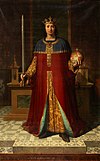 | The Saint | 30 August 1217 | 30 May 1252 | also King of León from 1230; all later kings were King of León as well |
| Alfonso X |  | The Wise | 30 May 1252 | 4 April 1284 | elected King of the Romans in 1257, a title which he claimed until he renounced it in 1275 |
| Sancho IV |  | The Brave | 4 April 1284 | 25 April 1295 | |
| Ferdinand IV |  | The Summoned | 25 April 1295 | 7 September 1312 | |
| Alfonso XI |  | The Just | 7 September 1312 | 26 March 1350 | Infected and killed by the Black Death during the Fifth Siege of Gibraltar (1349–1350) |
| Peter |  | The Cruel | 26 March 1350 | 23 March 1369 | Killed by Henry II of Castile |
Following the death of Peter, a succession crisis arose between Peter's illegitimate half-brother Henry of Trastámara and the Englishman John of Gaunt, a great great grandson of Ferdinand III of Castile, who claimed the title of King of Castile and Léon by virtue of his marriage to Constance, daughter of Peter. Henry took the throne by force, and faced several military actions by John of Gaunt, who had forged an alliance with John I of Portugal in an attempt to enforce his claim, however John of Gaunt was unsuccessful in his campaigns, and Henry established the House of Trastámara as the new ruling dynasty of Castile.

Henry II was the illegitimate son of Alfonso XI. He was made count of Trastámara.
| Monarch | Image | Epithet | Began | Ended | Notes |
|---|---|---|---|---|---|
| Henry II |  | The Bastard | 23 March 1369 | 29 May 1379 | also claimed the throne from 1366 |
| John I |  | 29 May 1379 | 9 October 1390 | ||
| Henry III |  | The Infirm | 9 October 1390 | 25 December 1406 | |
| John II |  | 25 December 1406 | 21 July 1454 | ||
| Henry IV | 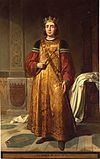 | The Impotent | 21 July 1454 | 11 December 1474 | |
| Isabella I |  | The Catholic | 11 December 1474 | 26 November 1504 | After ruling for a month on her own, Isabella was then joined by her husband, Ferdinand, who ruled Castile jure uxoris as Ferdinand V. |
| Ferdinand V |  | The Catholic | 15 January 1475 | 26 November 1504 | In Concordia de Segovia, Archbishop Carrillo and Cardinal Mendoza wrote the opinion on 15 January 1475 that Ferdinand was jure uxoris King of Castile. Succeeding to the throne of Aragon as Ferdinand II on 19 January 1479, Ferdinand then ruled all of non-Portuguese Iberia except Granada (added in 1492) and Navarre (added in 1515) effectively creating a de facto united realm of España . |
| Joanna |  | The mad | 26 November 1504 | 12 April 1555 | in name, with her husband Philip I (1504–1506). with regent Archbishop Cisneros (1506-1508). in confinement from 1509, with her father Ferdinand V (1508–1516). in confinement, with her son Charles I (1516–1555) |

| Monarch | Image | Epithet | Began | Ended | Notes |
|---|---|---|---|---|---|
| Philip I |  | The Handsome | 26 November 1504 | 25 September 1506 | jure uxoris king ruling on behalf of his wife, Joanna I |
| Charles I |  | The Emperor | 13 March 1516 | 16 January 1556 | jointly with his mother Joanna I in confinement to 1555, abdicated in favor of his son 1556, died 21 September 1558. |
| Philip II |  | The Prudent | 16 January 1556 | 13 September 1598 | son of Charles I and Isabella of Portugal |
| Philip III |  | The Pious | 13 September 1598 | 31 March 1621 | son of Philip II and Anna of Austria |
| Philip IV | 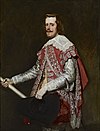 | The Great | 31 March 1621 | 17 September 1665 | son of Philip III and Margaret of Austria |
| Charles II |  | The Bewitched | 17 September 1665 | 1 November 1700 | son of Philip IV and Mariana of Austria |

| Monarch | Image | Epithet | Began | Ended | Notes |
|---|---|---|---|---|---|
| Philip V |  | 1 November 1700 | 1715 (Nueva Planta decrees dissolve the Crown of Castile) | Duke of Anjou, half-grandnephew of Charles II (via Maria Theresa of Castile) | |
The Crown of Castile existed in its own right within the Spanish crown and with its own law until the arrival of the Bourbon dynasty after the War of Spanish Succession.
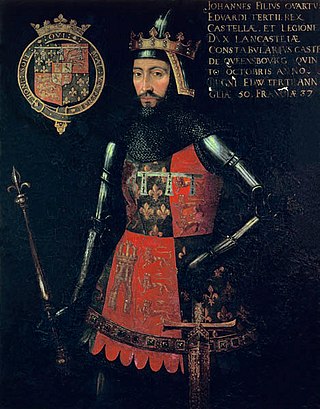
John of Gaunt, Duke of Lancaster was an English-French royal prince, military leader, and statesman. He was the third surviving son of King Edward III of England, and the father of King Henry IV. Due to Gaunt's royal origin, advantageous marriages, and some generous land grants, he was one of the richest men of his era, and was an influential figure during the reigns of both his father and his nephew, Richard II. As Duke of Lancaster, he is the founder of the royal House of Lancaster, whose members would ascend the throne after his death. His birthplace, Ghent in Flanders, then known in English as Gaunt, was the origin of his name. When he became unpopular later in life, a scurrilous rumour circulated, along with lampoons, claiming that he was actually the son of a Ghent butcher. This rumour, which infuriated him, may have been inspired by the fact that Edward III had not been present at his birth.

Peter, called Peterthe Cruel or the Just, was King of Castile and León from 1350 to 1369. Peter was the last ruler of the main branch of the House of Ivrea. He was excommunicated by Pope Urban V for his persecutions and cruelties committed against the clergy.

Ferdinand I, sometimes called the Handsome or occasionally the Inconstant, was the King of Portugal from 1367 until his death in 1383. He was also briefly made King of Galicia, in 1369. Facing a lack of legitimate male heirs, his death led to the 1383–85 crisis, also known as the Portuguese interregnum.

Henry II, called Henry of Trastámara or the Fratricidal, was the first King of Castile and León from the House of Trastámara. He became king in 1369 by defeating his half-brother Peter the Cruel, after numerous rebellions and battles. As king he was involved in the Fernandine Wars and the Hundred Years' War.

Prince or Princess of Asturias is the main substantive title used by the heir apparent or heir presumptive to the throne of Spain. According to the Spanish Constitution of 1978:
Article 57 [...] 2. The heir apparent or presumptive, from birth or event that makes him such, will have the dignity of Prince of Asturias and other titles traditionally linked to the successor of the Crown of Spain.

Beatrice was the only surviving legitimate child of King Ferdinand I of Portugal and his wife, Leonor Teles. She became Queen consort of Castile by marriage to King John I of Castile. Following her father's death without a legitimate male heir, she claimed the Portuguese throne, but lost her claim to her uncle, who became King John I of Portugal, founder of the House of Aviz.

The 1383–1385 Portuguese interregnum was a civil war in Portuguese history during which no crowned king of Portugal reigned. The interregnum began when King Ferdinand I died without a male heir and ended when King John I was crowned in 1385 after his victory during the Battle of Aljubarrota.

The Kingdom of Aragon was a medieval and early modern kingdom on the Iberian Peninsula, corresponding to the modern-day autonomous community of Aragon, in Spain. It should not be confused with the larger Crown of Aragon, which also included other territories—the Principality of Catalonia, the Kingdom of Valencia, the Kingdom of Majorca, and other possessions that are now part of France, Italy, and Greece—that were also under the rule of the King of Aragon, but were administered separately from the Kingdom of Aragon.
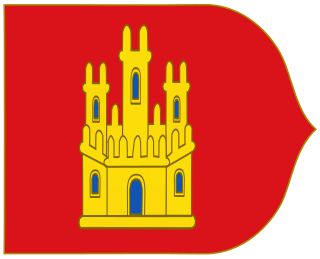
The Kingdom of Castile was a large and powerful state on the Iberian Peninsula during the Middle Ages. Its name is popularly thought to come from the castles built in the region. It began in the 9th century as the County of Castile, an eastern frontier lordship of the Kingdom of León. During the 10th century, its counts increased their autonomy, but it was not until 1065 that it was separated from León and became a kingdom in its own right. Between 1072 and 1157, it was again united with León, and after 1230, this union became permanent. Throughout this period, the Castilian kings made extensive conquests in southern Iberia at the expense of the Islamic principalities. The Kingdoms of Castile and of León, with their southern acquisitions, came to be known collectively as the Crown of Castile, a term that also came to encompass overseas expansion.

The House of Trastámara was a royal dynasty which first ruled in the Crown of Castile and then expanded to the Crown of Aragon in the late middle ages to the early modern period.

The Crown of Castile was a medieval polity in the Iberian Peninsula that formed in 1230 as a result of the third and definitive union of the crowns and, some decades later, the parliaments of the kingdoms of Castile and León upon the accession of the then Castilian king, Ferdinand III, to the vacant Leonese throne. It continued to exist as a separate entity after the personal union in 1469 of the crowns of Castile and Aragon with the marriage of the Catholic Monarchs up to the promulgation of the Nueva Planta decrees by Philip V in 1715.

The Castilian Civil War was a war of succession over the Crown of Castile that lasted from 1351 to 1369. The conflict started after the death of king Alfonso XI of Castile in March 1350. It became part of the larger conflict then raging between the Kingdom of England and the Kingdom of France: the Hundred Years' War. It was fought primarily in Castile and its coastal waters between the local and allied forces of the reigning king, Peter, and his illegitimate brother Henry of Trastámara over the right to the crown.

The Anscarids or the House of Ivrea were a medieval dynasty of Frankish origin which rose to prominence in Northern Italy in the tenth century, even briefly holding the Italian throne. The main branch ruled the County of Burgundy from the eleventh to fourteenth centuries and it was one of their members who first declared himself a count palatine. The cadet Castilian branch of Ivrea ruled the Kingdom of Galicia from 1111 and the Kingdoms of Castile and León from 1126 until 1369. The House of Trastámara, which ruled in Castile, Aragon, Naples, and Navarre at various points between the late 14th and early 16th centuries, was an illegitimate cadet branch of that family.

The Third Fernandine War was the last conflict of the Fernandine Wars, and took place between 1381–1382, between the Crown of Castile and the Kingdoms of Portugal and England. When Henry II of Castile died in 1379, John of Gaunt, 1st Duke of Lancaster claimed their rights of the throne of the Kingdom of Castile, and found an ally Ferdinand I of Portugal.

The Castilian House of Ivrea, also known as the House of Burgundy, is a cadet branch of the House of Ivrea descended from Raymond of Burgundy. Raymond married Urraca, the eldest legitimate daughter of Alfonso VI of León and Castile of the House of Jiménez. Two years after Raymond's death, Urraca succeeded her father and became queen of Castile and León; Urraca's and Raymond's offspring in the legitimate line ruled the kingdom from 1126 until the death of Peter of Castile in 1369, while their descendants in an illegitimate line, the House of Trastámara, would rule Castile and Aragón into the 16th century.
The Treaty of Bayonne in 1388 ended a conflict over the succession to the crown of Castile. The treaty was signed on 26 October 1388 in Bayonne between King John I of Castile and John of Gaunt, Duke of Lancaster, claimant to the throne of Castile in the right of his wife.